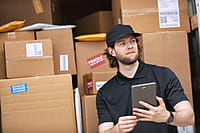Last week, at Stocksy United, there was a buyer request to support for some images of people watching television or movies. I think it’s great that buyers and designers can get right in and talk with management to let them know what they are looking for in the collection. Back on topic, I thought this would be a perfect opportunity to use my home theater set up as part of a shoot. Today, I’m actually going to discuss the electronics behind the room for people out there who may be working on a similar project.
My “man cave” is down in the basement. It’s not a very large area, and it isn’t a home version of a movie theater with columns and popcorn stands 🙂 . I do, however, have some home theater seating, which I bought about ten years ago. When we finally had our basement finished in 2011, I knew I wanted to incorporate at least a few cool features, along with a nice flat screen television. I had originally been using a projector, but it’s hard to play on the Wii when the ceilings are only 8 feet and you can only go 6 feet back from the screen. This big shadow gets in the way.
This is the television area, obviously. Our builder was really skilled with custom cabinetry, and he put together this cool wall unit, as well as suggesting the semi-circle in the ceiling. Now, one of the things I want to point out is the lighting behind the television. It’s known that adding some backlight to a television can help with eyestrain, and also give the appearance of improved picture quality. You can certainly buy some basic rope lighting at any home improvement store and fix it to the back of your set. However, this is the 21st century, and I knew we could do better than that!
This is a picture of LED strip lighting. Specifically, it is this kit from barlighting.com . This kit is super easy to use, and the strips are just stuck on the back of the panel with double sided poster tape. It comes with four strips, and I found the arrangement above gave pretty even lighting on the back wall. You do have to make sure your TV is a small distance from the wall to give the light space to spread. Since this is a multi-color LED strip, it can do pretty much any color using the included remote. I will have to say that the primary colors look the best – the white isn’t perfect. Who wants white when you can do high tech blue, anyways? One issue is that the remote for these lights is IR (infrared), so you need to dangle the sensor somewhere where the remote can “see” it. Below, you can see the white cord sticking out next to the Kinect unit.
Our contractor, during early discussions, had suggested running some rope lighting around the top of the entertainment area, behind the ceiling molding. That’s something I had seen before, and always thought it added that extra excitement to the room. Once again though, why go with one color rope lighting when you can have it all? After shopping around a while, I eventually found a company right here in St. Louis, about 15 minutes from my house, that sells all kind of LED lighting – superbrightleds.com . What I ended up with was several rolls of flexible RGB LED strips , plus accessories. If you want details because you are doing a similar project, here’s the order:
- 6 | NFLS-RGB150: RGB 150 High Power LED Flexible Light Strip| $ 129.95
- 30 | RGB-4Wire: Four Conductor RGB Wire (1 foot length)| $ 0.30
- 1 | LDRF-RGB4: RGB Controller w/ RF Remote | $ 39.95
- 1 | PS-12VDC-xW: 12 Volt DC Power Supply | $ 89.95 SP-200-12: 200Watt
- 1 | POWERCORD: Power Cord for Power Supplies | $ 4.95
Now, I am no electrician, so I worked with my contractor to make sure I had the right parts for him to set it up. It was all new to him as well, but it went mostly snag free. The color changing is handled by the RGB controller, and the first one was bad and only would display a red color. All the strips seemed to work though, so while waiting for another controller, they were installed and the molding went up. When we got the new controller, we discovered that one of the strips was actually out of sync in one area, although the red displayed correctly. Sigh. So we had to get another roll, and the molding had to come off and then back up. Now, everything was working fine. One thing to keep in mind – if you will be at eye level to the lighting at any point, you will be able to see the points of light from each LED. However at ground level, they make a nice even glow. You could even do better with the 300 LED strip instead of the 150.
Here are images of the strip set to blue and then to red.
There didn’t seem to be any issues with it getting around corners. You can even cut the LED strip so it will be the exact length you need. Something to keep in mind, is that the power source has a nice sized transformer, which has a fan for cooling. You will hear this if you do not take precautions. We hid it behind a panel in the ceiling, but you can still hear it. Nice thing, though, is that the strip is dimmable in steps from the remote, and the lower the power, the quieter the fan. The remote for these strips is RF (radio signal) and there is no problem with the signal going through the panel or drywall to get to the controller. Here’s the panel.
Here is an image of the remotes side by side – the larger is for the TV lighting and the smaller for the overhead. Even though they are separate remotes and systems, the colors of the lights match pretty spot on. The TV strip light remote lets you program your own colors, while the overhead remote is limited to the ones on the remote. But they both can do fun “dance party” light change fading (although not in sync).
So, my fun technology splurge for the basement was to the INSTEON lighting system. I get all my home electronics like this from SMARTHOME, and I’ve never had a problem. INSTEON is a system that allows INSTEON products to be controlled by other INSTEON products. So, to start with, I have a main keypad by the stairs that can control all the lights and controls.
Aside from the top left “MAIN” button, which I don’t use, each button can be used to program any number of actions on other controllers. My “B” button (basement !) is programmed to turn on all the lights at full power, and then another push turns them off. “E” is on right now, because that is the setting for “entertainment” – the overheads are set to 20%, the under cabinet lights are on at 80% and the overhead LED strips are turned on. This last part really concerned me during planning. Normally, with rope lighting, you would wire the lights into a dimmable wall switch with no issues. I wanted to do the same with the LED system, but wasn’t sure if I could just leave the LEDs “on” all the time and use the wall switch to turn them on and off. Happy to say that it does work fine with an INSTEON wall switch. It remembers it’s last setting for on/off, color, etc. with no issues. Here’s the wall switch that controls the LED strip lighting overhead (nothing exciting here).
So, the main touchpad sends a signal here to turn on when “E” is pushed. Or you can walk over and manually turn the switch on. Button “G” activates the SWITCHLINC controllers that turn on the colored lights in the wall unit, as well as the strip lights behind the TV. I made sure during planning to have outlets installed in the upper shelving areas of the unit so I could put some lights up there, as well as enough outlets behind the TV and in the bottom of the wall unit to handle all the electronics. These are units that you plug into the wall, and then whatever you plug into them can be controlled by INSTEON.
All this stuff is pretty easy to install, although the electricians were decidedly not excited about working with something new. However, I told them all they had to do was just install the switches like any other switch. Setting up the programming takes a little practice, but eventually you get the hang of it and start having fun.
So that’s my theater set-up. I know all this stuff can be daunting for someone just starting out, so hopefully this helped get you on the right track. Cheers!



















[…] few weeks ago here on the blog, I detailed a little “behind the scenes” of the “watching television at home” stock photo session that I did in response to a […]